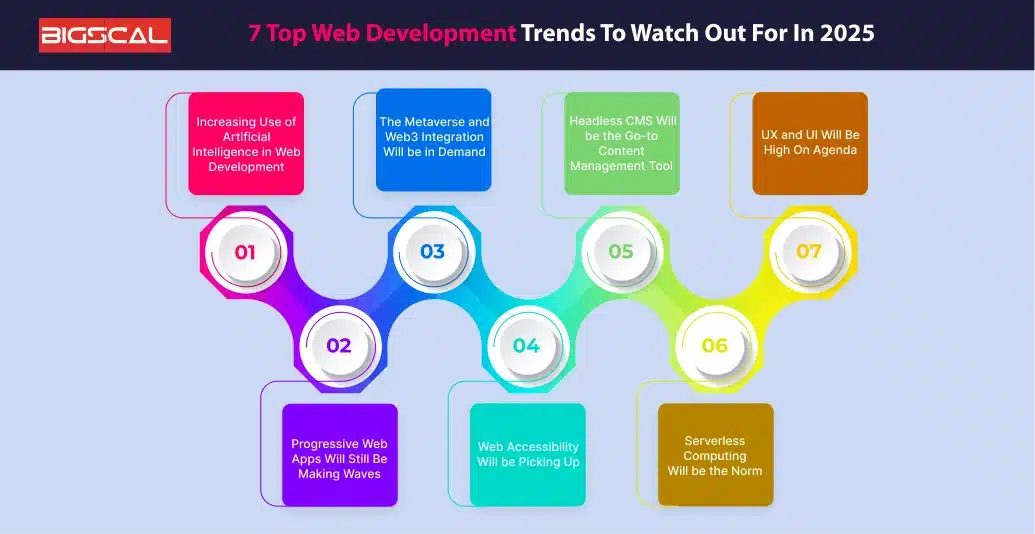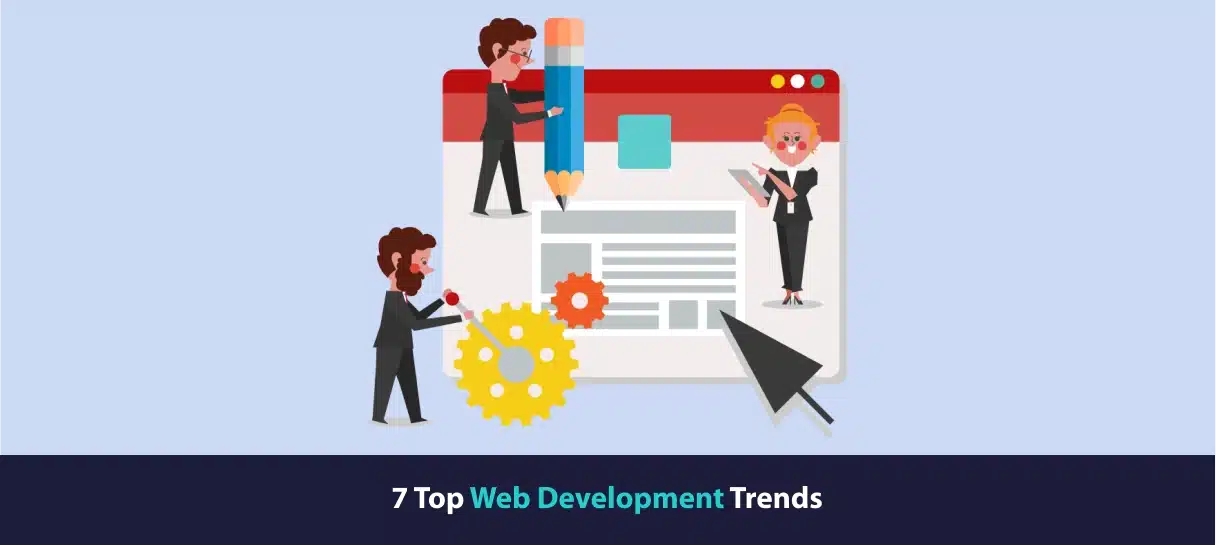7 Top Web Development Trends to Eye Out for in 2025
Quick Summary: Take a look at the top 7 web development trends in the year 2025-from AI-innovative steps to higher standards of web design at unmatched growing pace. It will be of most relevance for developers willing to improve their skills and get prepared for changes within their profession.
Introduction
With technology evolving quickly, user expectations are equally changing rapidly, and so are web development trends. Indeed, web developers are pushing every inch in the tech frontier space to ensure they meet user expectations by adopting all the latest trending technologies.
For instance, artificial intelligence is being massively adopted for essential development, including personalization, ensuring a secure website, and so on. In short, AI tools provide a solution for anything and everything when it comes to website development.
In addition to AI, other technologies such as progressive web apps, metaverse and web3 integration, web accessibility, headless CMS, and serverless computing are among many other trends catching the attention of web developers’ teams globally.
So, if you intend to design or re-design your website this year, pay heed to these trends to gain one-up over your competitors.
Without further ado, let’s learn about the 7 top web development trends revolutionizing the web space.
7 Top Web Development Trends to Watch Out For in 2025

User expectations keep changing, so businesses must adopt these tech trends without any afterthoughts to keep up with them.
1. Increasing Use of Artificial Intelligence in Web Development
The use of AI in web development, in the form of Website Builders, AI Personalization, and AI Cyber Security, is significantly increasing. 77% of businesses are either harnessing AI or are planning to use it. For example, a web development company in Austin might leverage AI tools to streamline design, enhance user personalization, and strengthen security measures.
Here’s how these AI will revolutionize the web development world:
AI Website Builders
Before AI Website Builders, Website developers used hard-coded HTML, WordPress, and other website builders to develop a website, which took significant time. No more! With AI builders such as Wix, Jimdo, and CodeWP, among many others, a website can be developed in just a few hours.
While Wix and Jimdo are no-code platforms, Web developers can drag and drop features without writing a single code. CodeWP is a WordPress plugin that could be considered among low-code platforms and is primarily used for building excellent visual interfaces.
AI Personalization
According to McKinsey, 71% of consumers expressed that companies must be sensitive to their needs and tailor content to their requirements. The same report cited that 67% of customers are frustrated when their interactions with companies need to meet their requirements.
This is where AI’s personalization comes to companies’ rescue. By studying user data and behavior, web developers can leverage AI-powered tools to tailor messages, product descriptions, and services to individual requirements.
AI Cyber Security
AI empowers cybersecurity systems by analyzing good amount of data to find patterns, anomalies, and other clues to help predict cyber threats. Web developers can use popular AI cyber security tools such as Dracktrace, FortiAI, and CrowdStrike Falcon to detect and respond to cyber-attacks autonomously. These tools are programmed to identify anomalies in network traffic and user behavior to track potential attacks, bolstering your website defenses and mitigating risks.
The next trend that’s stirring up the web space in PWAs.
2.Progressive Web Apps Will Still Be Making Waves
Progressive Web Apps are economical, cross-platform solutions with offline capabilities such as push notifications and compatibility across multiple devices. Their single codebase reduces development costs while offering a native app-like experience. However, to fully leverage these benefits, businesses need the right technical expertise. Outsourcing progressive web app development services allows to utilize the expertise to build secure PWA with faster project delivery. Currently, PWAs are used by 6.3+ billion smartphone users globally.
Here’s how PWAs will transform the web development space:
Cost-effectiveness
PWA cross-platform development costs are much lower than native apps, which require a separate codebase for every Android, iOS, or desktop operating system platform.
With PWA, web app developers can leverage a single codebase that can be shared between your website, mobile app, and desktop app.
Offline capabilities
PWAs can run offline, just like WhatsApp. Previous messages can be read, and replies can be typed and sent once you’re back online.
They also support push notifications; users can update PWA even when the application is not running.
Platform Compatibility
Unlike native apps that run on only specific operating systems, PWAs operate on different operating systems, such as Android, iOS, and more. This means they can be installed and used on any device.
Besides PWAs, metaverse and Web3 integration are seen to be in rising popularity.
3. The Metaverse and Web3 Integration Will be in Demand
The demand for metaverse and Web3 integrations is rising as they offer visitors a more immersive and decentralized digital experience. Here’s how these trends will shape the future of web development:
3D Web Development
The metaverse provides 3D virtual environments where users can interact in real-time. Web developers can leverage WebGL, Three.js, and Babylon.js to conjure immersive 3D experiences in the browser.
Decentralization and Blockchain
Web3 provides a decentralized internet run on blockchain technology where data is no longer in the hands of centralized entities. Web developers can integrate blockchain-based services to power decentralized apps that leverage smart contracts for automation and interactions.
Non-Fungible Tokens (NFTs):
NFTs are a huge part of the Web3 ecosystem and are now in-built websites and apps to offer digital goods, collectibles, and exclusive experiences.
Next up is web accessibility, and you shouldn’t ignore this trend at any cost.
4. Web Accessibility Will be Picking Up
Web Accessibility is no longer only about assisting disabled people. It’s also about making sites accessible to mobile devices or those with slow network connections.
Web developers must comply with WCAG standards to ensure their websites are accessible.
For the starters, WCAG stands for Web Content Accessibility Guidelines (WCAG). Web developers must follow the guidelines in this detailed document to ensure that their Web Design New Jersey is accessible to all, including those with visual, hearing, mobility, and cognitive impairments.
Four ways Web Accessibility Guidelines will Turnaround the Web development space: People Having Visual Impairments
Visually impaired could suffer from low-level vision, color blindness, or even total blindness. Many depend on screen magnifiers, physical magnifiers, and software zoom capabilities or use screen readers that help them read digital text aloud. Web developers should play around with screen readers to understand their working style.
People Having Hearing Impairments
Deaf people have different levels of hearing loss. Some use assistive technology for hearing, but it’s not commonplace. Textual alternatives need to be provided to make things easier for them. Moreover, videos should have captions, and a transcript should be provided for audio content.
People Having Mobility Impairments
Mobility Impairments could be in the form of paralysis or loss of control of limbs, etc. Such disabilities also arise because of old age or hardware limitations when you don’t have a mouse. In such situations, controls should be made accessible through a keyboard.
People Having Cognitive Impairments
Cognitive impairment covers intellectual and even disabilities that come with age, such as difficulty thinking and remembering. Depression, schizophrenia, dyslexia, and attention deficit hyperactivity disorder are also part of it. Understanding content, inconsistency in webpage layout, and task completion can make things difficult for people suffering from such impairments. To make life easier for such people, include only simple content, videos to explain content, highlight special features, consistent page layout, and more. You can read more about website accessibility here.
Moving on to the 5th trend, that is, the Headless Content Management System that’s helping businesses cut costs considerably.
5. Headless CMS Will be the Go-to Content Management Tool
A headless CMS keeps content management and content presentation in different silos. In other words, the front-end and back-end are kept separate, enabling users to manage content in one place and reuse it across different digital channels without duplication issues. Moreover, the developer is free to use any technology on the back end without worrying that it might impact the front end.
82.91% of businesses leveraging CMS have helped them save time, money, and productivity.
Headless CMS helps with:
Omnichannel Delivery of Content
A headless CMS lets users deliver content to different digital channels, such as websites and smartwatches, from a centralized back end. This saves businesses from recreating and reformatting content across different CMSes.
Better security
Headless CMSes decoupled architecture offers greater protection from distributed DDoS attacks than traditional CMSes
Improved page performance
Headless CMSes perform better than traditional CMSes in page performance, that is, regarding the speed and responsiveness of a webpage or app.
Serverless Computing is next in line, and cloud providers are slashing the cost of serverless solutions to drive innovation
6. Serverless Computing Will be the Norm
Serverless Computing allows developers to build and run applications without worrying about the underlying infrastructure. They don’t have to own servers, as the cloud providers will do that for them. The benefits include:
Cost-effective: In a serverless computing model, organizations pay only for their resources, given its pay-per-use model.
Scalable: This scalable model makes managing workloads and increasing traffic easy.
Operational Efficiency: Since developers’ jobs are exclusively focused on writing codes, this speeds up the development lifecycle, freeing up resources for innovation and the development of important product features.
Finally, moving on to the evergreen UX and UI trends.
7. UX and UI Will Be High On Agenda
User experience and user interface design are two pillars of web development that ensure users have a pleasant experience of your website. As we know, UX design focuses on the overall user experience, while UI design singularly focuses on visual elements.
For UX and UI Design, web developers need to focus on the following three aspects:
Mobile-First Approach: With 58.2% of the traffic coming from mobile devices, prioritizing mobile design is crucial in the coming year and all the years to come.
Intuitive Navigation: With intuitive navigation, users can easily flip between all website pages.
Personalization : A personalizated website make users feel invited. When users website experiences sync with their inherent preferences it results in long-term customer loyalty.
Conclusion
There you are! Seven web development trends you need to leverage to ensure that your website is in keeping with the times. AI personalization should be tried immediately and not be kept on the back burner. And so are other trends cum technologies that I mentioned because by giving them a miss, you are losing out on your competition who’d be already experimenting with them. So lose no time and get aboard with the above trends.





